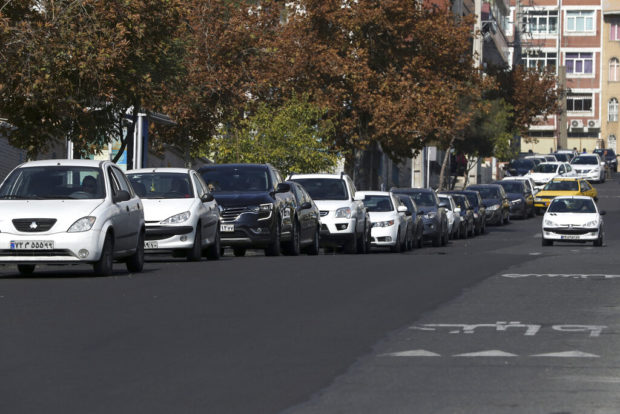
Vehicles queue to enter a gas station in Tehran, Iran, Friday, Nov. 15, 2019. Authorities have imposed rationing and increased the prices of fuel. The decision came following months of speculations about possible rationing after the U.S. in 2018 reimposed sanctions that sent Iran’s economy into free-fall following Washington withdrawal from 2015 nuclear deal between Iran and world powers. (AP Photo/Vahid Salemi)
DUBAI, United Arab Emirates — Protesters angered by Iran raising subsidized gasoline prices blocked traffic in several cities and clashed occasionally with police Saturday, the day after overnight rallies included an attempted attack on a regional oil depot that saw police and demonstrators exchange gunfire.
The demonstrations, though not as widespread as the economic protests that shook the country nearly two years ago, put new pressure on the government of Iran’s relatively moderate President Hassan Rouhani.
As parliamentary elections loom in February, Rouhani has been trying to pitch Iran on the idea of staying in his landmark 2015 nuclear deal with world powers. The accord is unraveling after President Donald Trump unilaterally withdrew the U.S. from it over a year ago, raising tensions across the wider Mideast.
Online videos showed peaceful protesters blocking traffic on Tehran’s Imam Ali Highway on Saturday, the first day of Iran’s working week, calling for police to join them as the season’s first snow fell. A large crowd in the city of Kermanshah demonstrated and later drew tear gas fire from police, a video showed. Others reportedly clashed in Tabriz, another major Iranian city.
State media did not immediately report on Saturday morning’s demonstrations. However, the online videos corresponded to Associated Press reporting and knowledge.
Violence broke out Friday night in Sirjan, some 800 kilometers (500 miles) southeast of Tehran. The state-run IRNA news agency said “protesters tried to set fire to the oil depot, but they were stopped by police.” It did not elaborate, but online videos circulating Iran purported to show fire at the depot as sirens wailed in the background. Another showed a large crowd shouting: “Rouhani, shame on you! Leave the country alone!”
Mohammad Mahmoudabadi, an Interior Ministry official in Sirjan, later told state television that police and demonstrators exchanged gunfire, wounding several. He said many protestors were peaceful, but later masked men armed with guns and knives infiltrated the demonstration.
“They insisted on reaching the oil depot and creating crises,” Mahmoudabadi said.
In Iran’s oil-rich Khuzestan province, online videos purported to show police firing tear gas on crowds.
Protests in Mashhad, Iran’s second-largest city and the home of a famous Shiite shrine, saw dozens of demonstrators abandon their cars in traffic Friday night, according to IRNA. The protest ended when police warned demonstrators to disperse, IRNA said.
Such protests require prior approval from Iran’s Interior Ministry, though authorities routinely allow small-scale demonstrations over economic issues, especially as the country has struggled with currency devaluation.
It wasn’t immediately clear if police made arrests. Iranian state television aired a segment Friday night trying to dispute the claims of opposition satellite news channels about the protests, calling their videos of demonstrations “fake news” in English. Iranian internet access meanwhile saw disruptions and outages Friday night into Saturday morning, suggesting “a response to limit attendance and media coverage of the protests,” according to the group NetBlocks, which monitors worldwide internet access.
Iran announced the cuts to gasoline subsidies at midnight Friday without any prior warning. It came after months of speculation over possible rationing. Iranian officials say the proceeds from Friday’s price hikes are earmarked to fund subsidies for low-income families.
Gasoline prices jumped to a minimum of 15,000 rials per liter of gas — 50% up from the day before. That’s 13 cents a liter, or about 50 cents a gallon. A gallon of regular gasoline in the U.S. costs $2.60 by comparison.
Iranian authorities have allocated a limit of 60 liters per month for every private car at about 13 cents per liter, and beyond that quota, the price jumps to 26 cents per liter, according to Iranian state media.
Previously, drivers were allowed up to 250 liters at 8 cents per liter, or 10,000 rials.
Iran is home to the world’s fourth-largest reserves of crude oil. Iranians long have felt subsidized gasoline was one of the only benefits it saw from its reserves. A similar push to limit subsidies saw protests in 2007.
“As in many countries, tinkering with the price of gas is politically explosive. After massive protests, the Hassan Rouhani administration was forced to back down from a 2017 plan to increase prices by 50%,” said Henry Rome, an analyst at the Eurasia Group. “The government was clearly attuned to this risk: The latest announcement was made in the middle of the night before a weekend, it took effect immediately, and it was announced without direct consultation with lawmakers.”
Iran long has suffered economic problems since its 1979 Islamic Revolution cut off its decades-long relationship with the U.S. Its eight-year war with Iraq in the 1980s followed, further straining its economy.
The collapse of the nuclear deal has exacerbated those problems. The Iranian rial, which traded at 32,000 to $1 at the time of the accord, fell to 120,000 to $1 in trading Saturday. Iran saw nationwide protests in late 2017 that extended into 2018 over its worsening economic situation, which resulted in nearly 5,000 reported arrests and at least 25 people being killed.
As in the 2017 protests, those now initially appear leaderless as well. They also come as major protests continue in Iraq and Lebanon, two Mideast nations home to Iranian proxies and crucial to Tehran’s influence abroad. /jpv